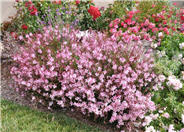
Common name:Catmint
Botanical name:Nepeta X faassenii
Nepeta faassenii makes soft, grey-green, undulating mounds to 1.5' high in bloom, spreading 3'-4' wide. The small leaves are attractive to cats. This perennial has lavender blue flowers in summer. Catmint can be planted in sun or shade and needs medium amount of water. Prune spent flowers to encourage more blooms.

Common name:Moonshine Yarrow, Milfoil, Sneezewo
Botanical name:Achillea 'Moonshine'
Long, straight stems with pale yellow flowers are striking on the mats of green to grey-green leaves of this plant, which are flatter and less divided than those of the Achillea millefolium. This Yarrow propagates easily from rooted cuttings or divisions which should be performed in the early spring or fall. Following bloom, one should dead head the plant and divide the clumps when it appears crowded. Introduced by Alan Bloom in the 1950's.

Common name:Azure or Russian Sage
Botanical name:Perovskia X atriplicifolia
This broad perennial will grow 3'-6' tall and has small, grey-green leaves with blue-violet flowers that bloom in the summer. Foliage is aromatic if brushed against it.

Common name:Lavender Cotton
Botanical name:Santolina chamaecyparissus
This groundcover-small shrub will grow to 3' tall and has small, greyish-silver leaves with yellow flowers that bloom in the summer.

Common name:Powis Castle Artemisia
Botanical name:Artemisia 'Powis Castle'
This mounding shrub reaches 3 ft. high and up to 5ft. wide with fine silver foliage. It does well in coastal areas as well as inland warm areas. It rarely blooms but is used for its beautiful foliage. It is striking next to perennials with bright colors. This shrub prefers full sun and well draining soil. It is drought tolerant once it's established.

Common name:Crape Myrtle
Botanical name:Lagerstroemia indica
The new leaves of this species are 2" long, bright green, and tinged with bronze. Some cultivars have spectacular fall color. When it has a bare outline, its rounded seed capsules add interest. Its delicate flowers bloom in 6"-12" long clusters. The flower colors could be shades of red, rose, pink, purple, and white, blooming in summer. It thrives on heat, and new cultivars have been created that resist mildew. This tree prefers full sun and has low watering needs once it's established.

Common name:Indian Summer Gloriosa Daisy
Botanical name:Rudbeckia hirta 'Indian Summer'
This biennial will grow 3'-4' tall and 1.5' wide. It has dark green leaves with yellow-gold flowers that bloom in summer and fall.

Common name:Whirling Butterflies White Gaura
Botanical name:Gaura lindheimeri 'Whirling Butterflies'
'Whirling Butterflies" is a profusely flowering perennial that grows 3' high. It has pink buds that open to showy white flowers (larger than other cultivars) in spring and summer. It needs full sun in most areas but afternoon shade in desert areas. It needs regular watering. This is a great plant for cut flowers and flower borders.

Common name:Chinese Wisteria
Botanical name:Wisteria sinensis
While the sinensis is similar to the floribunda, it bears more rounded, full clusters of strongly fragrant flowers which open more or less all at once. There are usually 13-15 leaflets per leaf, and they require full sun and average to little watering. It comes in many colors such as blues, whites and purples.-Monterey Bay Nursery

Common name:Border or Garden Penstemon
Botanical name:Penstemon hybrids (assorted)
This perennial plant will reach 3' high and has medium-sized, glossy dark green leaves with red, pink, lavender or purple flowers that bloom in summer and fall. It needs a bit extra water in the summer and no water in the winter. Hummingbirds love the flowers. This plant is great for cut flowers and color borders.
Sustainable landscaping is a term coined to mean sensible landscape practices that work within the limits of the Eco-system. This means within the limits of your local rainfall, soil conditions and sun patterns.
Click in the green box for more information
Designer: Terri Nichols
Photographer: GardenSoft
Incorporate compost 6" into your soil to retain water, reduce compaction, feed earthworms, and provide valuable nutrients to your plants.
Drip and other smart irrigation delivers water directly to roots, allowing no excess water for weeds.